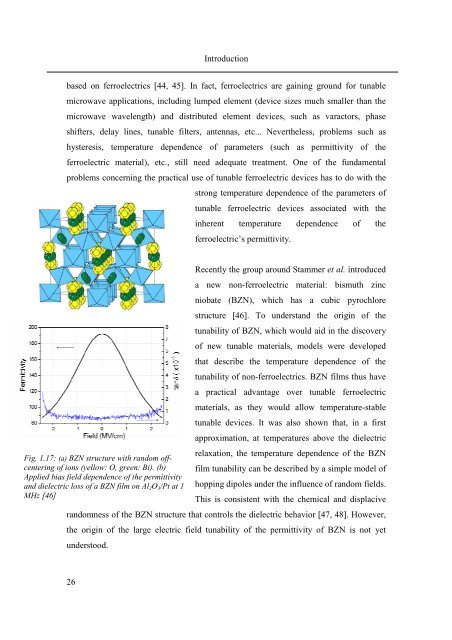PhD Thesis Arne Lüker final version V4 - Cranfield University
PhD Thesis Arne Lüker final version V4 - Cranfield University
PhD Thesis Arne Lüker final version V4 - Cranfield University
You also want an ePaper? Increase the reach of your titles
YUMPU automatically turns print PDFs into web optimized ePapers that Google loves.
26<br />
Introduction<br />
based on ferroelectrics [44, 45]. In fact, ferroelectrics are gaining ground for tunable<br />
microwave applications, including lumped element (device sizes much smaller than the<br />
microwave wavelength) and distributed element devices, such as varactors, phase<br />
shifters, delay lines, tunable filters, antennas, etc... Nevertheless, problems such as<br />
hysteresis, temperature dependence of parameters (such as permittivity of the<br />
ferroelectric material), etc., still need adequate treatment. One of the fundamental<br />
problems concerning the practical use of tunable ferroelectric devices has to do with the<br />
Fig. 1.17: (a) BZN structure with random offcentering<br />
of ions (yellow: O, green: Bi). (b)<br />
Applied bias field dependence of the permittivity<br />
and dielectric loss of a BZN film on Al2O3/Pt at 1<br />
MHz [46]<br />
strong temperature dependence of the parameters of<br />
tunable ferroelectric devices associated with the<br />
inherent temperature dependence of the<br />
ferroelectric’s permittivity.<br />
Recently the group around Stammer et al. introduced<br />
a new non-ferroelectric material: bismuth zinc<br />
niobate (BZN), which has a cubic pyrochlore<br />
structure [46]. To understand the origin of the<br />
tunability of BZN, which would aid in the discovery<br />
of new tunable materials, models were developed<br />
that describe the temperature dependence of the<br />
tunability of non-ferroelectrics. BZN films thus have<br />
a practical advantage over tunable ferroelectric<br />
materials, as they would allow temperature-stable<br />
tunable devices. It was also shown that, in a first<br />
approximation, at temperatures above the dielectric<br />
relaxation, the temperature dependence of the BZN<br />
film tunability can be described by a simple model of<br />
hopping dipoles under the influence of random fields.<br />
This is consistent with the chemical and displacive<br />
randomness of the BZN structure that controls the dielectric behavior [47, 48]. However,<br />
the origin of the large electric field tunability of the permittivity of BZN is not yet<br />
understood.

















